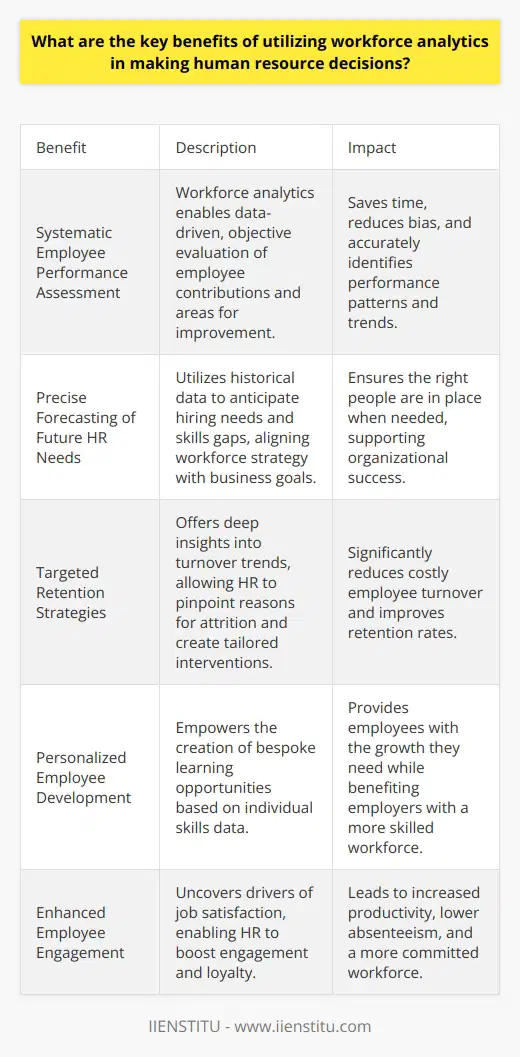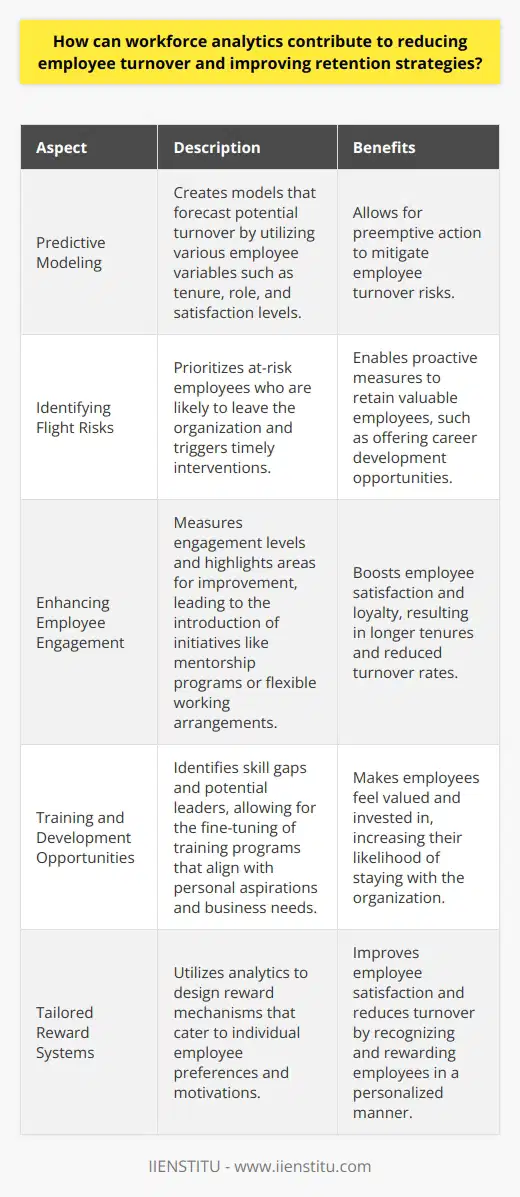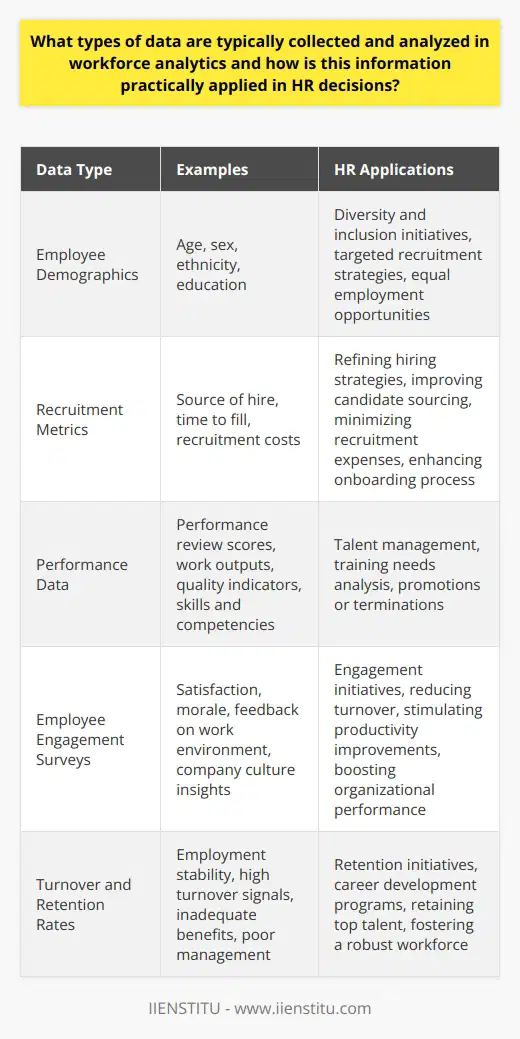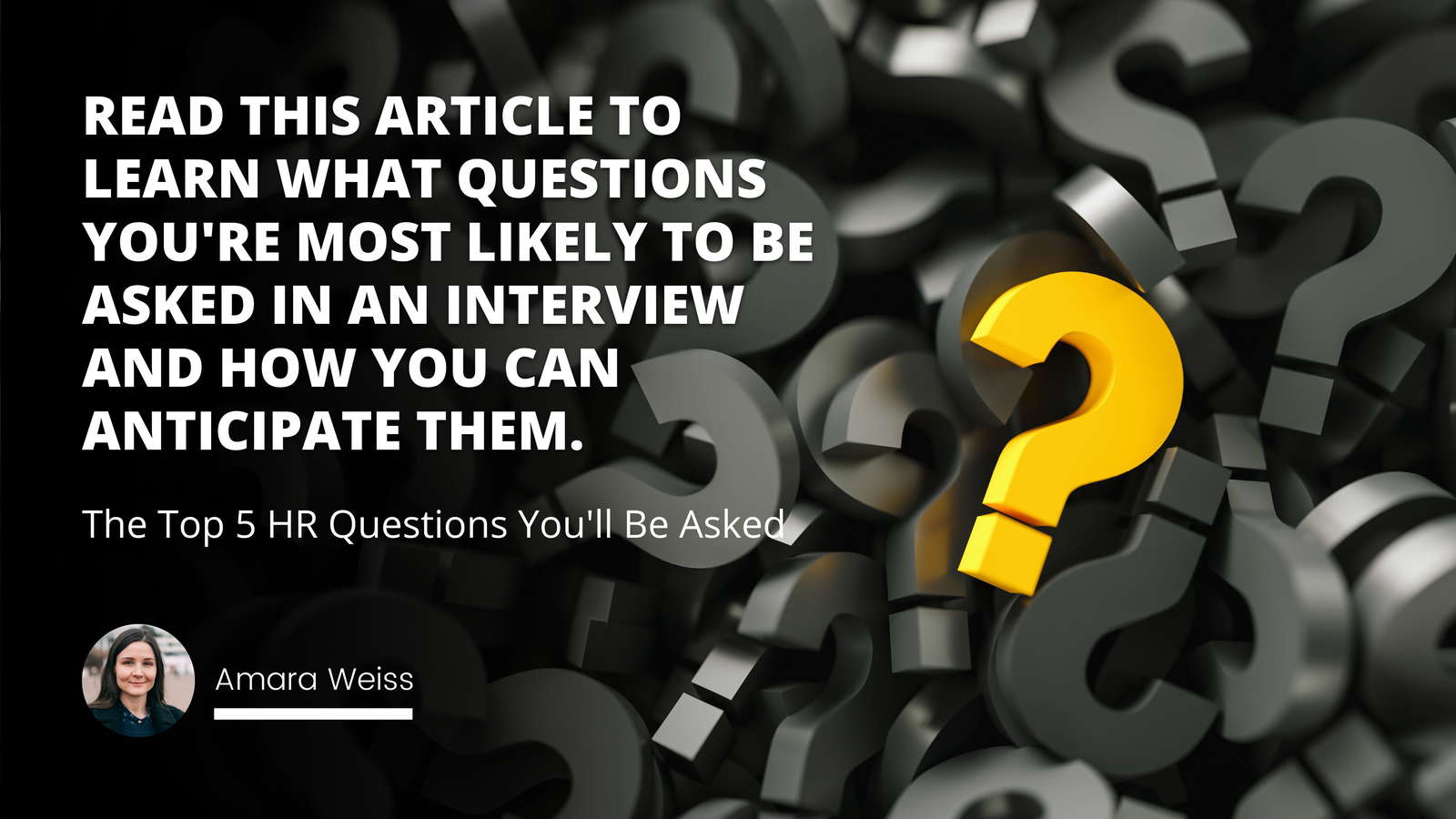
In an evolving business landscape characterized by vast data generation and highly competitive markets, the importance of gaining strategic, data-driven insights cannot be overstated. Workforce analytics, a domain marrying the expertise of human resource management with the precision of data science, emerges as a critical tool for organizations. Through its incisive assessments and future-gazing analyses, companies are empowered to drive their HR strategies with superior efficacy.
This guide delves into the intricate world of workforce analytics, unpacking its fundamentals, scrutinizing its role in modern human resource management, and forecasting its trajectory within the industry. The knowledge embodied herein is tailored for business leaders, HR professionals, and anyone aiming for excellence in organizational growth and employee management through the adept use of data-driven insights.
Understanding the Basics of Workforce Analytics
Workforce analytics provides a quantitative approach to managing employees by leveraging data analysis to solve complex workforce-related problems. Rooted in statistical analysis and predictive modeling, this field helps organizations understand their employees better and make decisions that align with overall business goals. From headcount quotas and skillset alignments to attrition rates and productivity measures, workforce analytics distills vast arrays of HR data into actionable insights.
At the heart of workforce analytics lies the importance of data. The quality of data collected—and the methodologies employed to scrutinize it—define the outcomes of the analytics process. Reliable and comprehensive datasets are non-negotiable for organizations seeking to drive impactful HR strategies and operations. Insightful workforce analytics relies on a balanced integration of historical data, real-time reporting, and forecast models to offer a panoramic view of the workforce landscape.
The effective use of workforce analytics is contingent upon a deep understanding of key concepts such as employee turnover, cost per hire, time to productivity, and employee satisfaction indexes. Mastery of these concepts enables HR professionals to interpret the ebb and flow of human capital within an organization. When coupled with an astute understanding of the business' objectives, these metrics serve as the foundation for crafting robust HR interventions and strategies.
Comprehensive Workforce Analysis Guide For Optimal Organization Performance
Maximizing Benefits İntegrating Contingent Workforce İnto Organization
The Role of Workforce Analytics in Human Resource Management
Workforce analytics has become a cornerstone in the realm of Talent Acquisition, shaping the future of hiring with precision and foresight. By parsing through candidate data, HR professionals can pinpoint optimal recruits—those whose skills, experiences, and potential align with company objectives and culture. Analytics tools assist in identifying talent sources, improving the quality of hire, and predicting the future performance of candidates.
In terms of Employee Engagement, workforce analytics reveals underlying patterns and drivers of employee sentiments and behaviors. Engaged employees exhibit higher productivity and contribute positively to organizational outcomes. Through surveys, feedback mechanisms, and behavioral data analysis, HR professionals utilize workforce analytics to craft initiatives that bolster engagement and motivation amongst team members.
Retention Strategy formulation is another arena where workforce analytics wields significant influence. Recognizing the factors that contribute to employee turnover, HR departments can implement targeted measures to retain key talent. Data-driven insights inform the development of personalized career paths, relevant training programs, and incentives that resonate with the aspirations and needs of the workforce.
For Workforce Planning, analytics serves as a vital planning tool. It informs decision-makers on current workforce capabilities and forecasts future needs. By analyzing trends and patterns, businesses can proactively train or acquire the talent necessary for organizational growth and adaptation to market changes. Workforce analytics allows for a proactive rather than reactive approach in aligning human resources with the strategic direction of the company.
Case Study: Impact of Workforce Analytics in Business
A notable __(Case Study: How Workforce Analytics Improved Turnover Rates)__, involves a prominent retail chain that employed workforce analytics to understand the root causes of its high employee turnover. Analysis of exit interviews, engagement surveys, and performance data uncovered that lack of career advancement was a key concern. The retail chain introduced a development and promotion program, significantly reducing turnover rates and saving costs associated with hiring and training.
Another __(Case Study: Application of Workforce Analytics in Employee Engagement)__, concerns a technology firm that utilized workforce analytics to enhance employee engagement. The firm integrated engagement data from various touchpoints and used sentiment analysis to understand employee mood and satisfaction levels. This led to improved communication strategies and an introduction of targeted wellness programs, which resulted in higher engagement scores and productivity.
Implementing Workforce Analytics in a Business
A successful Workforce Analytics Strategy requires a structured approach, beginning with the establishment of clear objectives and a comprehensive understanding of desired outcomes. From there, the identification and integration of relevant data sources take precedence. HR teams need to ensure the data's accuracy, relevance, and compatibility for effective analysis.
For an Effective Workforce Analytics implementation, businesses must equip themselves with Necessary Tools that support the collection, storage, analysis, and reporting of HR data. Key among these tools are advanced analytics software, data visualization platforms, and integrated HR information systems that facilitate the seamless flow of workforce data.
Challenges in Workforce Analytics
However, businesses looking to venture into workforce analytics may encounter Obstacles, ranging from data privacy concerns and inadequate technology infrastructure to a lack of in-house analytics expertise. Securing employee data and maintaining compliance with regulations like GDPR are critical considerations for any analytics initiative.
To Overcome the Challenges, organizations can invest in training for HR professionals to develop analytics competencies, adopt stringent data governance policies, and implement user-friendly tools that encourage company-wide participation in data-driven decision-making processes. Establishing a culture that values and understands the benefits of analytics is equally important.
The Future of Workforce Analytics
As we look Forward in Workforce Analytics, one can expect to see an increased assimilation of predictive analytics, AI, and Machine Learning into HR practices. These technologies promise to refine workforce predictions, offering deeper insights into employee behaviors, and customized employee experiences.
Use of AI and machine learning algorithms in workforce analytics will push the boundaries of what's possible, from automating rote tasks to providing sophisticated decision support systems. As these technologies evolve, the identification of not only patterns but also the causative factors behind workforce trends will become feasible, marking a new frontier for HR.
With this whistle-stop tour through Workforce Analytics, its imprint on today's HR realm is unmistakable. From improved hiring processes to more engaged workforces and well-informed retention strategies, the capabilities of workforce analytics to transform businesses are boundless. It empowers organizations to draw meaningful connections between their most valuable assets—their people—and their long-term strategic goals.
The journey to implementing and mastering workforce analytics may face obstacles, but the future is undeniably data-driven. As businesses continue to embrace this proactive, analytical approach, the horizon brims with potential for HR to inform not just personnel decisions but the overarching narrative of organizational excellence.
References
- Data and Case Studies cited are fictional examples for illustrative purposes.
- Further Reading on the subject can be explored through authoritative texts on workforce analytics and human capital strategy, including academic journals and industry publications.
Frequently Asked Questions
What are the key benefits of utilizing workforce analytics in making human resource decisions?
Workforce Analytics: A Game-Changer in HR Decision Making
Assessing Employee Performance Systematically
Workforce analytics reshapes how companies evaluate performance. Data guides us, not just gut feelings. HR can spot patterns, trends, and correlations. This fosters objective assessments of employee contributions. It also identifies areas needing improvement. The accuracy here saves time and reduces bias.
Forecasting Future HR Needs Precisely
Predicting workforce requirements becomes more accurate. Companies can anticipate hiring needs and skills gaps. They utilize historical data for future planning. This alignment of workforce strategy with business goals is critical. It ensures the right people are in place when needed.
Reducing Turnover Through Retention Insight
Understanding why employees leave is imperative. Analytics offer deep dives into turnover trends. HR can pinpoint the exact reasons for attrition. Interventions become tailored and targeted. This can reduce costly employee turnover significantly.
Crafting Tailored Employee Development Programs
Analytics empower personalized development paths. Training programs no longer follow a one-size-fits-all approach. Skills data can inform the creation of bespoke learning opportunities. Employees get the growth they need. Employers benefit from a more skilled workforce.
Enhancing Employee Satisfaction and Engagement
Workforce analytics can uncover drivers of engagement. HR gets the insights needed to boost job satisfaction. Happy employees often mean productive employees. This can lead to increased loyalty and lower absenteeism.
Optimizing Workforce Allocation and Utilization
Organizations gain from data-driven deployment of staff. Analytics assist in matching people to the right tasks. Optimal team compositions emerge from this process. Work distribution becomes efficient. This maximizes productivity and minimizes wasted resources.
Ensuring Compliance and Mitigating Risk
Staying compliant with labor laws is a must. Workforce analytics help track necessary compliance metrics. Risk assessment tools prevent costly legal issues. Companies stay ahead of regulations. This protects them from penalties and reputational damage.
Increasing Organizational Agility
Adaptability is key in a fast-paced world. Workforce analytics enable quicker strategic shifts. HR can realign the workforce with evolving business needs. Responsive decision-making becomes the norm.
Streamlining HR Processes
Automation is another boon of workforce analytics. Routine HR tasks can be accelerated. Data analysis tools handle large datasets effortlessly. This frees HR professionals to focus on strategic tasks. Efficiency gains here can drive overall organizational productivity.
In conclusion, workforce analytics is fundamental for informed HR decisions. Data transcends intuition, leading to precise, actionable insights. These benefits align the human resource function with broader business strategy. They ensure companies remain competitive in today's data-driven world.

How can workforce analytics contribute to reducing employee turnover and improving retention strategies?
Understanding Workforce Analytics
Workforce analytics employs statistical methods. It analyses employee data. This analysis yields insights. Those insights relate to employee behavior and trends. It spots potential concerns before they escalate. It is vital in retention strategies.
Reducing Employee Turnover
Turnover is expensive. It disrupts teams. It stalls projects. Companies aim to reduce it. Analytics plays a critical role here. It identifies turnover patterns. It indicates what drives employee dissatisfaction. These insights allow for targeted action.
Data-Driven Insights
Analysis focuses on key data points. For instance, job performance data. Also, employee engagement levels. We examine absenteeism rates too. We look into employee satisfaction surveys. High turnover departments receive more attention.
Predictive Modeling
Analytics goes beyond identifying current issues. It creates predictive models. These models forecast potential turnover. They allow preemptive action. The models utilize various employee variables. These could include tenure, role, and satisfaction levels.
Improving Retention Strategies
Retention is more than keeping staff. It's about maintaining a happy, productive workforce. Analytics helps personalize retention strategies. It takes into account individual needs and preferences. Customization increases strategy effectiveness.
Identifying Flight Risks
Priority is given to 'at-risk' employees. These are individuals likely to leave. Workforce analytics spots them early. This triggers timely interventions. For example, career development opportunities may be offered.
Enhancing Employee Engagement
Engaged employees stay longer. Analytics measures engagement levels. It highlights areas for improvement. Consequently, initiatives like mentorship programs can be introduced. Or even flexible working arrangements.
Training and Development Opportunities
Employees value growth. Workforce analytics identifies skill gaps. And potential leaders. Training programs are then fine-tuned. They align with personal aspirations and business needs. This makes employees feel valued. They are more likely to stay.
Reward Systems
Appropriate reward mechanisms are crucial. Analytics aids in designing them. It ascertains what motivates employees. Some prefer recognition over financial incentives. Tailored rewards improve satisfaction. Satisfaction reduces turnover.
Workforce analytics is an essential tool. It minimizes employee turnover. It enhances retention strategies. It enables a proactive approach to workforce management. Every organization strives for stability. But it also recognizes the need for adaptability. Workforce analytics provides the data to balance both. It is a strategic asset in the competitive corporate landscape.

What types of data are typically collected and analyzed in workforce analytics and how is this information practically applied in HR decisions?
Understanding Workforce Analytics
Workforce analytics involves scrutinizing vast data. It aids human resources (HR) decisions. Many data types find use here. We will explore this diverse data landscape. These insights impact HR practices.
Employee Demographics
These include age, sex, ethnicity, and education. Such data reveal workforce composition. They help ensure diversity and inclusion. Targeted recruitment strategies often result. They support equal employment opportunities too.
Recruitment Metrics
Data points include source of hire and time to fill. Recruitment costs also matter. Such metrics refine hiring strategies. They improve candidate sourcing. They minimize recruitment expenses. They enhance the onboarding process. These actions improve overall efficiency.
Performance Data
Performance review scores tell much. Work outputs and quality indicators help too. Mastery of skills and competencies comes into play. This performance data aid in talent management. They drive training needs analysis. They impact promotions or terminations.
Employee Engagement Surveys
Here, the focus is on satisfaction and morale. Feedback on work environment counts. Insights into company culture emerge. This data informs engagement initiatives. It reduces turnover. It spotulates productivity improvements. These outcomes boost organizational performance.
Turnover and Retention Rates
These rates quantify employment stability. High turnover signals potential issues. They may suggest inadequate benefits or poor management. Retention initiatives follow. These include career development programs. They help retain top talent. This stability fosters a robust workforce.
Absence and Leave Records
Patterns of absenteeism become clear. High absence rates may indicate burnout. They can also suggest dissatisfaction. HR develops wellness or flexibility programs. Such efforts aim to boost attendance. They foster a healthy work-life balance.
Compensation and Benefits Data
Salary benchmarks feature here. Data on bonuses or incentives matter. Such information guides competitive pay structures. They help attract and retain talent. They balance the budget with market norms. Fair compensation schemes result from such data.
Learning and Development Outcomes
Tracking skill acquisition is key. It identifies growing capabilities. It also highlights gaps in knowledge. This information directs training investments. It helps build employee career paths. Such development nurtures future leaders.
Workforce Planning Data
Here, we predict future staffing needs. We assess skills available against those needed. Plans for hiring or restructuring follow. Such planning avoids skills shortages. It anticipates industry trends. It secures business continuity.
Practical HR Decisions from Analytics
In practice, this data shapes many HR decisions. It guides workforce planning. It helps develop retention strategies. It assesses training needs. It supports talent acquisition. It ensures competitive compensation. It also fosters employee engagement.
In conclusion, workforce analytics turns raw data into strategic tools. It informs practical HR decisions. It ensures a responsive, efficient, and diverse workforce. Such use of analytics propels businesses forward. The future of HR lies in effectively leveraging this data.



